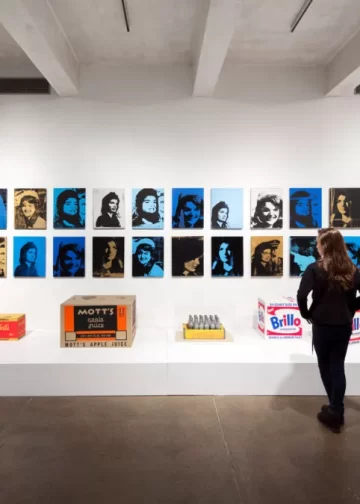
Andy Warhol, born Andrew Warhola in Pittsburgh, Pennsylvania, was a leading figure in the pop art movement of the 1960s. He was a prolific artist and filmmaker, and his work continues to be celebrated across the world. In his hometown of Pittsburgh, his life and work are celebrated at the Andy Warhol Museum, which was founded in 1994.
The Museum
The Andy Warhol Museum is the largest museum in the United States dedicated to a single artist. Located in a converted warehouse in Pittsburgh’s North Shore neighborhood, it houses an extensive collection of Warhol’s work, including paintings, prints, films, and videos. The museum also features temporary exhibitions highlighting other contemporary artists and offers educational programs for visitors of all ages.
Explore the Exhibits
First Floor
The first floor features the entrance hall, gift shop, and cafe. It also holds an exhibit on Warhol’s early years in Pittsburgh. Here, visitors can find photographs of the artist as a child, as well as early drawings and paintings from his time as a student at Carnegie Mellon University.
Second Floor
The second floor showcases the museum’s largest permanent collection, which includes Warhol’s famous prints of Marilyn Monroe, Elvis Presley, and other celebrities. Visitors can also find a room dedicated to Warhol’s celebrity portraits. Additionally, this floor features a section that showcases his work in advertising.
Third Floor
The third floor houses a collection of Warhol’s abstract paintings, created toward the end of his career. These paintings are characterized by their bright colors and repetitive patterns. Many of them also showcase Warhol’s signature diamond dust technique.
Fourth Floor
The fourth floor is dedicated to the museum’s film and video collection. Visitors can watch some of Warhol’s most famous films, including Sleep, Empire, and The Chelsea Girls. Additionally, there is a screening room available for visitors to view contemporary films and videos.
Discover the Iconic Art
The Andy Warhol Museum is a haven for anyone seeking to immerse themselves in the artistic brilliance of Andy Warhol. With an extensive collection of paintings, prints, films, and videos, this museum showcases the full scope of Warhol’s creativity. Marvel at his famous prints of Marilyn Monroe, Elvis Presley, and other beloved celebrities. Explore his abstract paintings, known for their vibrant colors and repetitive patterns. Immerse yourself in his avant-garde films, including Sleep, Empire, and The Chelsea Girls. The museum’s exhibits are a testament to Warhol’s impact on the art world and his ability to blur the lines between high and popular culture.
Engage with Interactive Exhibits
The Andy Warhol Museum provides visitors with more than just a passive viewing experience. Interactive exhibits and guided tours offer a deeper understanding of Warhol’s life and artistic process. Learn about his upbringing in Pittsburgh and his early artistic endeavors. Engage with hands-on activities that allow you to experiment with Warhol’s signature techniques, such as screen-printing and using vibrant color palettes. These immersive experiences make the museum an interactive playground for art enthusiasts of all ages.
Educational Programs and Events
The Andy Warhol Museum is not just a place for art appreciation; it also offers educational programs and exciting events throughout the year. Attend talks by renowned artists and curators who share insights into Warhol’s work and its impact on contemporary art. Participate in workshops where you can learn the techniques and processes that Warhol employed in his art. And don’t miss out on the museum’s vibrant and diverse lineup of concerts and performances, which celebrate the intersection of art and music.
Plan Your Visit
Located in Pittsburgh’s North Shore neighborhood, the Andy Warhol Museum is easily accessible to visitors. The museum’s website provides comprehensive information on hours of operation, ticket prices, and upcoming events. Whether you’re a local or planning a trip to Pittsburgh, a visit to the Andy Warhol Museum is an essential experience for any art enthusiast.
Conclusion
The Andy Warhol Museum is a must-visit destination for fans of pop art and contemporary art. With its extensive collection and educational programs, the museum offers visitors the opportunity to explore the life and work of one of the most influential artists of the 20th century. Discovering the museum not only offers insight into Warhol’s impactful contributions to the art world but also provides a deeper understanding of his roots in Pittsburgh.






